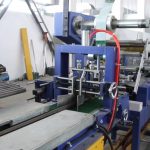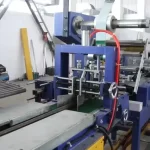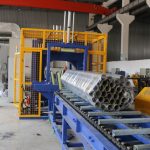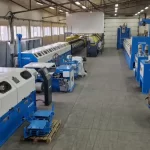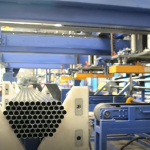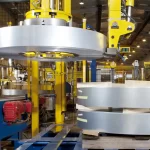I. Introduction
The steel tube industry is a vital sector, supplying essential materials for construction, automotive, and oil and gas industries.
Efficient and reliable packing solutions play a crucial role in maintaining product quality and ensuring safe transportation.
This article aims to provide essential information on packing solutions for potential investors in steel tube mills and factories.
II. Overview of Steel Tube Packing Solutions
Various packing methods are used to protect steel tubes during transportation and storage. Some common methods include:
1. Bundling:
In this method, multiple steel tubes are grouped together and secured with straps, wires, or bands. Bundling is suitable for tubes of similar size and shape, making it easier to handle and transport them.
The bundles can be hexagonal, square, or other shapes, depending on the tube dimensions and customer requirements.
2. Boxing:
Boxing involves placing steel tubes inside wooden or cardboard boxes, which provide additional protection against impacts and environmental conditions.
This method is useful for smaller tubes or those with special coatings that require extra care during handling and transportation. Boxes can be custom-sized to fit the tubes and can be stacked for efficient storage and transport.
3. Wrapping:
Wrapping steel tubes in protective materials, such as plastic film, foam, or paper, helps prevent scratches, corrosion, and other damage during handling and transportation.
This method is particularly useful for tubes with special coatings or finishes. The wrapping can be applied manually or using automated equipment, depending on the factory’s capabilities and needs.
4. Strapping:
Strapping involves securing steel tubes with steel or plastic straps to ensure they remain in place during transportation.
This method can be used in conjunction with other packing techniques, such as bundling or boxing, to provide extra stability and protection. Strapping can be done manually or with automated equipment.
5. Automatic steel tube packaging systems:
These sophisticated systems use automation and robotics to handle various packing tasks, such as bundling, boxing, wrapping, and strapping.
Automatic packaging systems can streamline the packing process, increasing efficiency and reducing labor requirements.
These systems can be customized to accommodate different tube sizes, shapes, and materials, ensuring optimal protection and handling.
III. Automation vs. Manual Packing Systems
Automated and manual packing systems offer different advantages and disadvantages. Some key factors to consider when choosing between automation and manual packing include:
1. Cost:
Automated systems may have higher upfront costs but can reduce labor expenses in the long run.
2. Efficiency:
Automated systems can streamline the packing process, increasing throughput and reducing human error.
3. Product requirements:
Some specialized steel tubes may require manual packing to ensure proper protection and handling.
IV. Key Factors to Consider When Choosing a Steel Tube Packing Solution
When selecting a packing solution for your steel tube mill or factory, consider the following factors:
1. Factory layout:
Ensure the packing solution fits within the available space and integrates seamlessly with existing equipment.
2. Cost:
Evaluate the total cost of ownership, including initial investment, maintenance, and labor costs.
3. Efficiency:
Determine how the packing solution can improve productivity and reduce waste.
4. Customization:
Assess the solution’s ability to accommodate various tube sizes, shapes, and materials.
5. Performance:
Evaluate the reliability and durability of the packing solution over time.
6. Maintenance and support:
Consider the availability of technical support and maintenance services to keep the packing solution running smoothly.
V. Sustainable and Eco-friendly Packing Solutions
Sustainability is an increasingly important concern in the steel tube industry. Eco-friendly packing solutions can help reduce waste and minimize the environmental impact of the packing process. Some sustainable practices include:
1. Using recyclable or biodegradable packing materials
2. Optimizing packing designs to minimize material usage
3. Implementing energy-efficient packing equipment
VI. Safety Considerations in Steel Tube Packing
Maintaining a safe working environment is essential in any steel tube mill or factory. To ensure safety when implementing packing solutions, consider the following measures:
1. Ergonomics:
Design the packing area to reduce strain and injury risks for workers.
2. Proper training:
Train employees on safe packing procedures and equipment operation.
3. Regular maintenance:
Schedule routine maintenance to prevent equipment malfunctions and safety hazards.
VII. Customized Packing Solutions for Specialized Steel Tubes
Certain steel tube applications may require specialized packing solutions due to their unique properties or transportation requirements.
Examples include coated tubes, high-precision tubes, and large or heavy tubes. In these cases, working with a packing solution provider to develop customized approaches is essential to meet the specific needs of your steel tubes.
VIII. Evaluating the ROI of Packing Solutions
When choosing a packing solution, it’s important to consider the return on investment (ROI). Factors that can affect the ROI of your packing solution include:
1. Increased efficiency:
Faster, more reliable packing processes can boost productivity and reduce labor costs.
2. Reduced labor costs:
Automated packing solutions can lower labor expenses by requiring fewer workers.
3. Improved product quality and customer satisfaction:
Properly packed steel tubes are less likely to be damaged during transportation, leading to higher customer satisfaction and fewer returns.
IX. Future Trends in Steel Tube Packing Technology
As the steel tube industry evolves, packing technology is expected to advance as well. Potential future trends include:
1. Greater adoption of automation and robotics for increased efficiency and precision.
2. Integration of smart technologies, such as IoT devices, to monitor and optimize packing processes in real-time.
3. Development of new materials and designs that improve product protection while reducing environmental impact.
